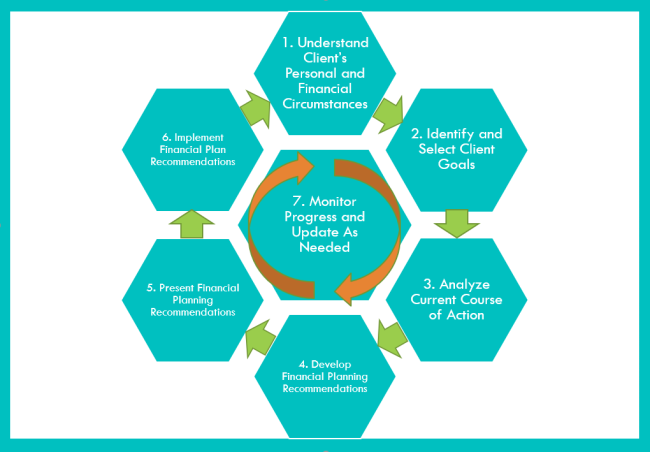While every client's experience will necessarily be a little different because of different goals and circumstances, the general flow of a typical engagement is illustrated below for reference.
Introduction.
Every relationship has to start somewhere. We like to schedule an introductory call to discuss your needs and expectations. Based on the conversation, we will recommend an engagement and next steps, or, if a prospective client isn't a good fit for the types of services we provide, we generally will recommend alternatives.
Engagement.
Once we've mutually agreed to move forward with an engagement, we will provide an advisory or financial planning agreement for signatures between the client and advisor. The agreement will specifically spell out our compensation and the services we have agreed to provide. At the same time, you will receive our regulatory disclosures which we are required to provide.
This is also the point where we generally will gather asset information and initiate any asset transfers to our custodian, TD Ameritrade Institutional. By initiating the transfers at this point, we can concurrently be working through the financial planning process while assets are in transition, and we can generally be ready to implement immediately following the plan presentation and review meeting.
The Financial Planning Process.
The graph below lays out the general steps in the financial planning process. Some additional explanation is provided right below the graph.
Step 1: Understand Client's Personal and Financial Circumstances
We will set up an encrypted client portal where we can exchange statements and information without the risk of e-mailing sensitive documents. We will request a list of documents to review such as investment asset statements, mortgage and debt information, tax returns, insurance policy declarations, estate and legal documents, etc. We will also look at income and expenses to get a feel for the flexibility to save for particular goals, to be determined in the next step.
Step 2: Identify and Select Client Goals
This is where we discuss your desired outcomes. We generally break these goals into Needs (groceries, mortgage payments, utilities), Wants (prioritized discretionary expenses such as home improvement or paying for college), and Wishes (dream goals if there are funds available after paying for Needs and Wants). These goals are what makes every client's plan unique, so we really want to spend some time to figure out what these goals are and how each goal ranks relative to others.
Step 3: Analyze Current Course of Action
To determine a baseline, we start by assessing your likelihood of meeting your goals should you make no changes from your current situations.
Step 4: Develop Financial Planning Recommendations
Based on a review of the current course of action, this is where our professional expertise comes into play. We will leverage our expertise and team to develop strategies which will usually improve client outcomes. This includes an assessment of a client's current versus recommended investment strategy, savings and debt repayment plans, reserves to meet unanticipated contingencies, and tax-related opportunities to maximize the plan's success.
Step 5: Present Financial Planning Recommendations
Following our analysis and plan design, we will sit down with our clients to review our findings and recommendations. The purpose of the presentation is to come to an agreement on a course of action.
Step 6: Implement Financial Plan Recommendations
Based on the agreed upon course of action, we will typically initiate plan implementation, though there are exceptions wherein actions are required by the client. For example, we may refer you to an external professional if life insurance or estate planning changes are warranted. Note that we never get or pay any referral fees when we refer to external professionals.
Step 7: Monitor Progress and Update as Needed
Financial planning is an ongoing process. Life changes. People get married, and some divorced. People change jobs. They have kids, grandkids, retire, suffer health issues, pass away, etc. All of these life changes can require us to update a client's plan, which we feel is essential as life circumstances change.
As mentioned above, every client relationship is slightly different. While you can expect to follow the general process above, we may focus on the steps in a different order depending on your priorities and needs. To find out if we can help, please fill out the "Get in Touch" form at the bottom of this page.
Financial Planning Investment Management Tax Reduction Planning

